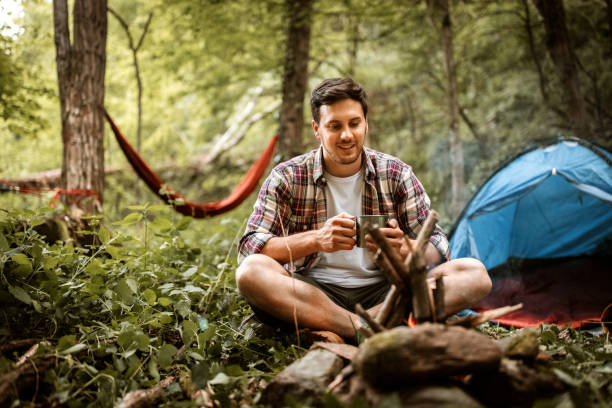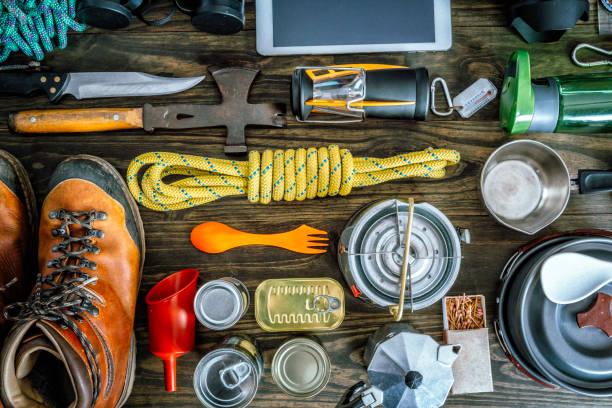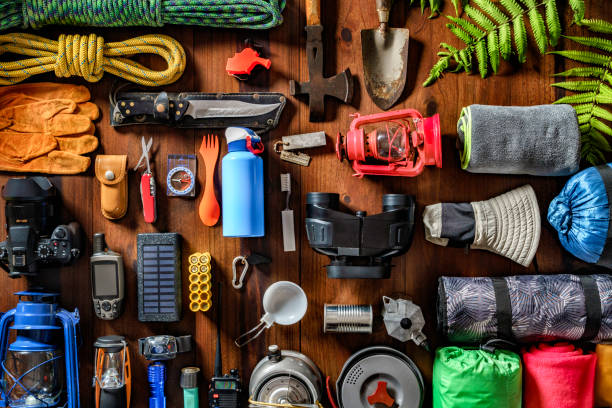Building your first bug out bag can seem like a daunting task to a beginner survivalist. Everyone you read about has spent months or even years fine-tuning theirs and has amassed a collection of equipment. It can be difficult to know where to begin, but if you learn the fundamentals of survival, you will still be in a much better position than 99% of people.
A bug out bag, also known as a BOB, I.N.C.H. Bag (I’m Never Coming Home Bag), Get Out of Dodge Bag (GOOD Bag), or 72 Hour Bag, is typically created to get you out of a crisis situation and enable you to survive independently for up to three days. There is always a limit to what you can carry on your back, and a 3-day target is a good place to start. Many people plan their bug out bags to last them for much longer than that.
Why Should You Have a Bug Out Bag?
Without adequate planning, you put yourself and your loved ones in danger because disasters can happen at any time. Whether you’re facing a natural disaster or chemical warfare, there is no better time than the present to prepare a bug out bag full of the necessities.
Survival depends on being prepared, but a startling 48% of Americans don’t have enough supplies to use in case of an emergency. Thus, when disaster strikes, almost half of the population won’t be prepared.
Every survivalist’s top priority should be to prepare a thorough, survival-ready bug out bag. We’ve collaborated with a team of experts to outline some of the most essential survival tools, materials, and gear needed to weather the storm, whatever it may be.
Essentials for a Bug Out Bag
Water and Hydration
Perhaps the most crucial bug out bag necessities is those that pertain to water and hydration. The human body can survive without food for about three weeks, but only for about 72 hours without water. In your bug out bag, water is an absolute necessity. It is strongly advised that each person drink no less than one liter per day.
Below, you can see the items we recommend:
• Drinking Water (3 Liters)
• Collapsible Water Bottle
• Hard Water Bottle
• Metal Water Bottle / Canteen
• Water Filters / Purification Systems
• Water Purification Tablets (Qty 3)
Out of everything mentioned above, we strongly advise packing a Sawyer or two for water filtration. These small, lightweight lifesavers remove 99.9% of bacteria and other harmful microbes from water that would otherwise have to be boiled or treated in some other way before they could be consumed.
Food and Food Preparation
You’ll need enough food to last three days or more when bombs or flooding begin. You can survive those crucial first moments with the aid of these necessities, and you’ll have the strength you need to face any challenges that come your way.
• Rations: Since there won’t be much room in your bug-out bag for a feast, these compact, dense packages of food are essential. Datrex emergency rations are calorie-dense and give you enough food to last three days.
• Fishing gear: A compact fishing kit may be useful if an emergency leaves you stranded close to water. An on-the-go fishing solution can be created by tying string, a hook, and bait to almost anything.
Clothing
We all have different body types, tolerances, and levels of fitness, so choosing to clothe for your bug out bag requires careful consideration. To always keep a healthy body temperature, the items on the list below should be strategically layered.
It goes without saying that your choice of clothing will be influenced by your environment, the weather, and the other factors mentioned above. Every season, you ought to review your bug-out bag. You’ll want to have a wardrobe that you can switch out as needed during these times, with a variety of seasonal clothing.
Your ability to always have a dry set to wear depends on having at least two changes of clothing. You don’t want wet clothing when you’re bugging out and exposed to the elements. In addition to being uncomfortable, hypothermia is a serious issue that should not be ignored.
• Lightweight Long Sleeve Shirt (made of poly fabric, not cotton)
• Convertible (Zip-Off) Pants
• Underwear
• Merino Wool Hiking Socks (Qty 3 pair) – Not scratchy like traditional wool!
• Medium Weight Fleece
• Hat w/ Flex Brim
• Working Gloves
• Rain Poncho
• Shemagh
Shelter and Bedding
Some of the items we’ve chosen for this category may appear excessive or even unpractical at first glance to a seasoned survivor. However, if you look at each of the items we suggest, you’ll notice that they are all designed with the backpacker in mind and are all small and light.
Yes, you can use a trash bag filled with leaves as a makeshift ground pad or a tarp to create a shelter, but these are all items we believe are wise to include for a number of reasons. When things are difficult, having a good night’s sleep—both physically and mentally—is crucial for morale.

Heat Source
When bugging out, it’s also crucial to have multiple ways of starting a fire. The following essentials are suggested for every bug out bag. The reason is, a survivalist and firearms expert friend of ours shared this piece of wisdom which has stuck with us ever since –
“There is one where there are two. Where one exists, none exist.”
In essence, this means that you are doomed if your primary system fails and you don’t have a backup.
Because of this, we advise including at least three different fire-starting techniques on your list of things to pack for a bug out bag.
• Lighter
• Ferrocerium Rod
• Tinder (Qty 3)
• Waterproof Storage
First Aid Kit
It would take a separate article, if not several, to try to cover everything you should include in your bug out bag first aid kit. I won’t attempt to cover it in this essay because I will undoubtedly forget something.
Making your own first aid kit is preferable to purchasing one of those prepackaged first aid kits that boasts having 1001 items to help you through any emergency. While some are fine, in my experience these kinds of kits are typically packed with a lot of items you are unlikely to need and not nearly enough of the items you will most likely need a lot of.
Additionally, creating your own first aid kit gives you a thorough understanding of what it contains and how to use it. How many people purchase one of those pre-assembled sets and then assume they are ready because there is so much garbage in it that they must find what I need? Bad Idea.
It might be more cost-effective to buy a pre-made first aid kit, keep the items you require, and discard the rest. Then add those additional items to your kit after making your purchase.
Hygiene
When assembling a list of necessities for a bug out bag, we’ve discovered that several facets of personal hygiene are frequently forgotten. However, the consequences of skipping any of these for an extended period of time could result in bacterial infections and a rapid decline in health. Packing these things will help you bug out when you need to be at your best.
• Wet Napkins
• Hand Sanitizer
• All-Purpose Camp Soap
• Hygiene/Signal Mirror
• Small Pack Towel
• Travel Toilet Paper (Qty 2)
• Travel Size Toothbrush & Toothpaste
• Other Personal Hygiene Necessities
Tools
This is the category that people obsess over the most, second only to weapons. And it’s simple to understand why. Devices are cool, and some of them are particularly delightful. But as we’ve said before, “every ounce counts.” Decide on the essentials and disregard the rest. We suggest the three items below for your bug out bag in an effort to live by what we preach.
Stay tuned because we’ll be sure to go into more detail about our thinking in a later post, but for now, these should work well for most, if not all, bug out bags.
• Survival Knife
• Multi-Tool
• Axe (much safer than a machete and the butt can double as a hammer)

Lighting
When the sun sets, lighting equipment is essential. Navigate to any area from sundown to sunrise using the following bug out bag essentials:
• Chemical-grade light sticks can last up to 12 hours and are typically visible up to a mile away. Strong output and a long shelf life make these durable lighting tools excellent for signaling, deterring animals, and providing basic illumination.
• A flashlight is a necessity for any bug-out bag. Purchase a powerful flashlight that is both sturdy and portable.
• Headlamp: If there is space in your bug-out bag, think about including a headlamp for hands-free lighting.
Self Defense
There is no doubt that this is a contentious issue, and (WARNING: Broad Generalization Ahead!) it’s been our experience that Most of the people here who are Americans tend to fall into this category. We can certainly understand why since we are Americans. J
We all need to think very carefully about self-defense. In the worst-case scenarios, bugging out means choosing between living and dying. It’s entirely up to you whether you decide to carry a handgun, a rifle, both, or just a can of pepper spray. We will, however, be well prepared to defend ourselves and, if necessary, go hunting for wild game in the event of a bug out.
We strongly advise some level of self-defense training if you choose not to carry a weapon or are not permitted to do so. This is especially important if you have a family as they will be depending on you for their safety.
Please let us know what you would like to read more about in the comments below as we will definitely be writing more posts on this subject in the future.
• Pepper Spray
• Handgun
• Takedown rifle
• (At least 100 rounds of ammunition) for each firearm)
Summary
Once you’ve taken care of these fundamentals, you can start to test and improve your bug out bag with additional practical gear and get it ready for longer-term survival situations.
Not all of us have the time or knowledge necessary to assemble a quality bag. If you only need a single ready-to-use bag or a starter kit to get things started, be sure to check out the bags.

